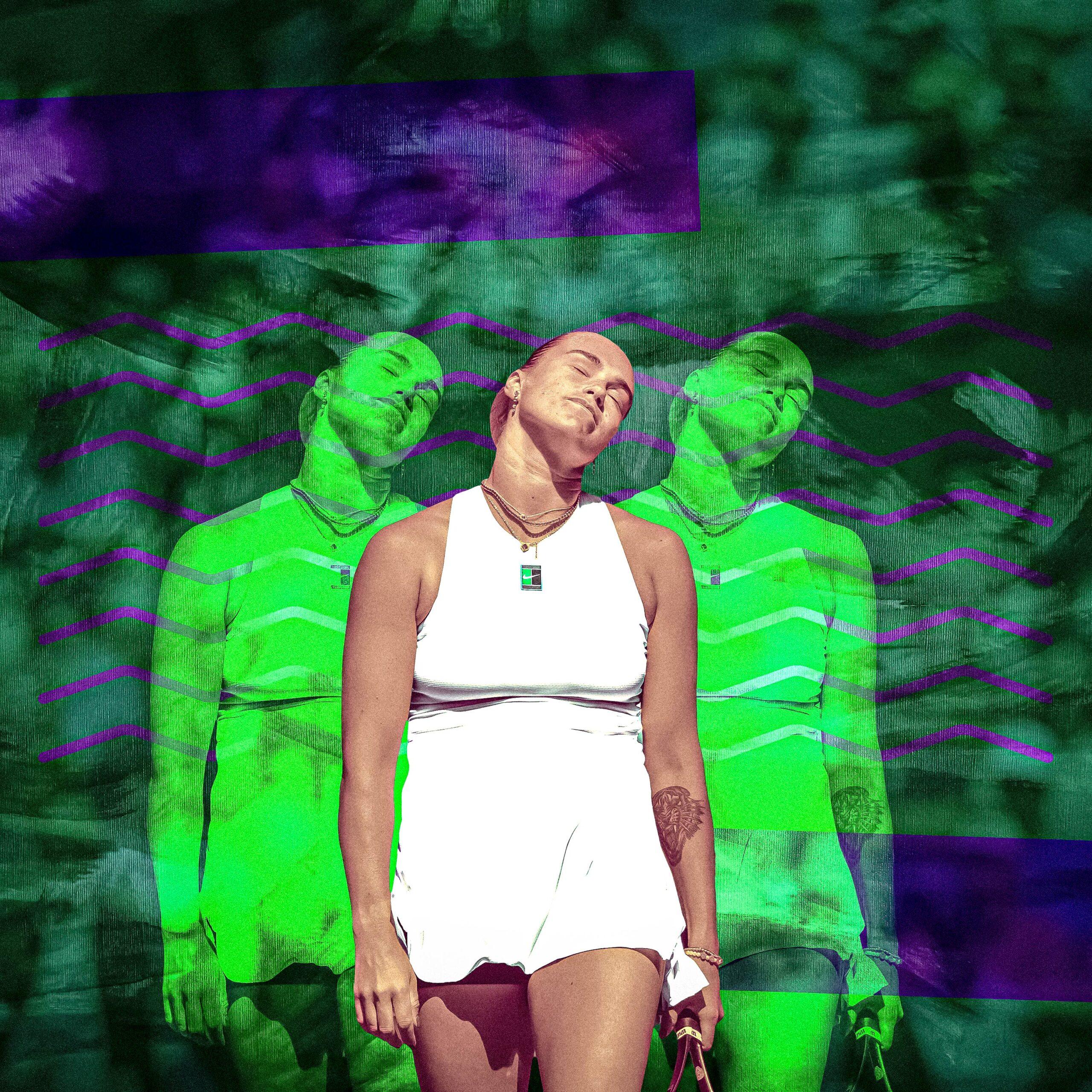
When the mood strikes her, as it generally does several times in the course of a match, Aryna Sabalenka assumes a facial expression that’s one of the most imperious things I’ve ever seen on a tennis court. This is not hyperbole. Tennis is a sport that’s heavy on close-ups. If you watch a lot of it, the faces of the players, the way they react to shifts of momentum and circumstance, become part of the punctuation of a tournament. Novak Djokovic jerking his head and muttering to himself after a bad shot, Carlos Alcaraz squinching his eyes and baring his teeth after a dramatic winner—these are the periods and commas connecting passages of play. The expression of Sabalenka’s I have in mind isn’t as kinetic as those looks; in fact, it’s almost perfectly still. When the camera finds it, though, it hits like an exclamation mark.
The expression often appears when she’s waiting for her opponent to serve. She’s crouching, on alert, with her racket in front of her. Her eyes are narrowed. Her eyebrows look like they could cut through a steel door. Her face projects total determination. She frowns slightly, with an unparseable combination of disdain, authority, and acceptance, as if she were saying (to her racket? To her opponent? To you?), You mosquito, I shall permit you to exist.
Give it two minutes, though, and there’s a good chance Sabalenka’s expression will be completely different. The 27-year-old Belarusian star is the dominant force on the WTA tour, the no. 1 player in the world, and a three-time major winner. But after her crushing 4-6, 6-4, 4-6 loss against the 13th-seeded Amanda Anisimova in the Wimbledon semifinals on Thursday, she’s also a player who’s underperformed at three consecutive majors, a player with a lengthening record of not quite living up to the biggest moments, and, most strangely of all, an undisputed superstar who often seems to beat herself. I find her intensely fascinating—far more fascinating than many of her less gifted, more consistent rivals—in part because her struggles against her own on-court demons are as titanic as many great matchups involving two players. Sabalenka is an epic rivalry all by herself.
She’s prone to astonishingly violent bouts of nerves and frustration. Often, when things start to go wrong, that imperious calm vanishes. She gets impatient. She gets agitated. She tosses her hands in the air. She berates herself. When she misses a shot, she looks bitterly satisfied, as if the error confirmed that she was right to be disgusted with herself. This year’s Wimbledon, especially on the women’s side, has been one of the most chaotic tournaments in recent memory, with top seeds falling in droves. Coco Gauff, the second seed, who beat Sabalenka in the French Open final just a few weeks ago, lost to the unseeded Dayana Yastremska in the first round; Jessica Pegula, the third seed, also lost in the first round, to the unseeded Elisabetta Cocciaretto. Sabalenka was the only one of the top five seeds to escape the second round. She made it to the final eight without dropping a set, but all her self-defeating tendencies have been on display. At one point, in her quarterfinal match against the German Laura Siegemund, a 37-year-old doubles specialist currently ranked 104th in the world, Sabalenka bashed herself in the back of the head with her own racket, not gently, several times in a row.
There have been greater players than Sabalenka, and there have been players more consumed by self-doubt, but there may never have been a player in whom self-doubt and dominance coexisted to this disorienting an extent. Tennis players as a group are prone to intense swings of emotions, for reasons that aren’t hard to understand: They’re alone on the court, playing a game that asks them to unleash furious power while maintaining millimeter accuracy. When their shots aren’t landing, fixing their game can feel like repairing a sports car engine while driving 120 mph down the track, all while 10,000 backseat drivers look on. But even among tennis players, Sabalenka’s passions stand out.
One of the many things spectator sports give us is a chance to see extraordinarily gifted people in moments of duress, when character reveals itself under pressure. Take our fascination with so-called clutch athletes, for example. It’s riveting to watch Tyrese Haliburton sink buzzer-beater after buzzer-beater in the NBA playoffs, because it seems to suggest an almost magical dimension of human potential: What if life actually could get easier for us as the stakes got higher? Sabalenka is riveting in the opposite way. For her, it gets harder as the stakes rise. She has to fight to overcome the difficulty, and her inner struggle is separate from, and sometimes more dramatic than, her struggle against her opponent. Often she wins anyway; sometimes, as against Anisimova on Thursday, she doesn’t.
I’d love to say I went through life like Haliburton, with unshakable confidence and a borderline supernatural ability to back it up. Wouldn’t that be fun? But personally, I find it easier to identify with an athlete who gets down on herself when she screws up, even when she knows getting down on herself will only make her screw up more. I find it easier to identify with an athlete who knows irritation and anxiety are self-defeating qualities, and therefore tries to stop herself from feeling them, and therefore gets even more irritated and anxious when she can’t block them out. In my perfect dream of life I’m a Haliburton, but on an average Tuesday afternoon, when I have 10 emails to answer and work due on deadline and I forgot to eat lunch and my dogs are barking at squirrels, I’m a Sabalenka all the way. And it’s the way she makes Tuesday afternoon so compelling—the way she turns the struggle against our everyday irrationality and counterproductivity into an elemental drama—that makes her so absorbing to watch.
Sometimes, it has to be said, this can lead to profoundly ugly tennis. Sabalenka has been ranked no. 1 for all of 2025, but she has a 3-4 record in finals, and some of the losses have been brutal. In the French Open final against Gauff, which Sabalenka lost in three sets, she won the first set in a tiebreak and then seemed to freeze, mentally. Routine shots sailed wide or cudgeled into the net. Her shoulders got high and tense; her movement looked labored. Between points she stalked around snapping at herself. She fell apart completely, hitting 70—70!—unforced errors; all Gauff had to do was hold her composure and keep hitting the ball into play. After the match, Sabalenka drew criticism for saying that if Iga Swiatek, the former world no. 1 and winner of the three previous French Opens, had made the final in her place, Swiatek would have beaten Gauff. This was interpreted as disrespectful to Gauff, but I think Sabalenka meant to be disrespectful only to herself: Beating her hadn’t required anything very special from Gauff, the way beating Swiatek might have done, because Sabalenka had effectively pre-defeated herself.
At times, though, even the ugly matches become weirdly inspiring, as Sabalenka manages to quiet her negative self-talk and still her inner turbulence. Deep in the third set of the Wimbledon quarterfinal against Siegemund, almost immediately after bonking herself with her racket, she reset, composed herself, and turned absolutely lethal. Siegemund had broken her service game six times over the course of the match; the most recent break gave Siegemund a chance to serve for a 5-3 lead in the set. Sabalenka broke her back. The imperious expression made its long-awaited appearance. She started firing off aces. She won 12 of the last 16 points in the match, and Siegemund was helpless to stop her.
At her best, there are few active players who can stop her. Her game isn’t complex—she serves powerfully, hits the ball extremely hard, and controls points from the baseline—but it’s versatile. Her forehand is concussively beautiful; when she won the U.S. Open last year, balls off her forehand averaged 80 mph. She loves constructing quick 1-2 points off her serve: Force her opponent into a weak return, then obliterate a forehand winner. Lately, she’s been incorporating more variety into her game. At 3-3 in the first set against Anisimova, with the game at deuce and Anisimova serving, what looked like a typical exchange of power-baseline shots took an unexpected turn when Sabalenka played a cheeky cross-court drop shot to win the point. If she can develop that aspect of her game, look out. Though, being Sabalenka, she dumped her next return into the net and made a “What were you thinking?” gesture, smacking her forehead with both hands.
In a way, it’s tough to blame her for the loss to Anisimova. Wimbledon has been a cursed tournament for top seeds this year, and she outlasted most of her rivals. Anisimova, a 23-year-old American, has historically been a tough matchup for her—Sabalenka was 3-5 against her coming into Thursday’s semifinal—and is playing the best tennis of her life. (She’ll move into the top 10 for the first time in her career next week.) Sabalenka played well for long stretches of the match. She didn’t give it away. Still, there were inexplicable mental errors at the biggest moments. She double-faulted to give Anisimova the first set; later, on a key point in the third set, with Anisimova about 10 miles out of position, she hit what should have been an easy forehand smash into an open court well long, the kind of mistake that makes the commentators wail in amazement. That point gave Anisimova a break and a 3-1 lead in the set. I should have been rooting for Anisimova, my fellow American, but I found myself pulling desperately for Sabalenka to overcome the spirit of Tuesday afternoon and prevail.
But that’s the hell of Tuesday afternoon. From the outside it doesn’t look like much. But when you’re in it, it can feel impossible to escape.

